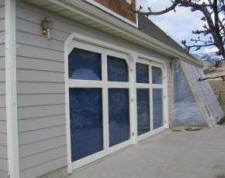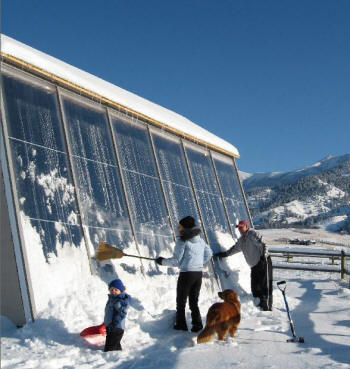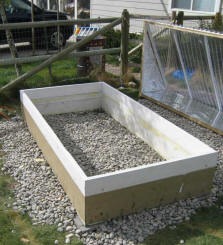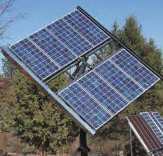
Search
The Renewable Energy site for Do-It-Yourselfers
1/2 -- Solar Energy Projects
|
These are the 5 solar energy projects
we decided on: 3 completed -- 1 in-planning -- 1 future.
The totals to date for Solar
Projects are:
14,600 KWH/yr energy saving.
3.3 tons/yr reduction in carbon
dioxide emissions.
$1,180 in energy savings per
year.
Total cost of projects $4,900
First year return of 24%
Future projects include a sunspace
and a solar electric system -- these will result in further decreases in energy
use and greenhouse gases.
Again, your list of projects may be
much different -- see the Planning Section. for ideas
on making a good list. |
|
My house is not well designed or
oriented for solar heating. It has a high heat loss due to large
areas of glazing. These large glazed areas face ENE, so they have minimal solar
gain in the winter. But, with some effort, we managed to get the heat loss
down quite a bit, and to design solar space heating collectors that will (in the
end) provide half or more of the homes heat. If your house is well
oriented for solar, you may be able to do better for less work.
Solar Projects
Solar Space Heating
| Thermosyphon Shop Heater |
| This thermosyphon
solar shop heater covers most of the south wall of my shop/barn, and is the
only form of heat it has. The collector is simple, cheap, efficient, and
makes a good DIY project. The More Information link has the full
description.
Note that if you heat a building that you use frequently with this
collector, and you live in a cold climate, the payback period will likely be inside of one year!
More information |
 |
| Energy Saving/yr |
2527 KWH |
Initial Cost |
$350 |
DIY Labor |
28 hrs |
| CO2 reduction |
1323 lb |
$'s Saved/year |
$206 |
DIY difficulty |
6 |
| Energy Source |
Propane |
1st Year Return |
59% |
|
|
| |
|
10 yr saving (10% fuel inflation per year) |
$3282 |
|
|
Cost Estimate:
The cost for all the materials was $350.Dollar Saving:
I estimated the usable heat gain with a simple simulation that is similar to
this
example simulation.
The results were that the collector gains about 13.8 Million BTU for the season.
This is equivalent to 187.5 gallons of propane when burned in an 80% efficient furnace.
I only used half of these estimates, because I do not use the shop full
time, and would not heat it beyond keeping it above freezing on days I don't
use it. |
| Direct Gain Collector |
| This is a direct gain
solar collector that heats my shop/attached garage. The big glazed
panel doors heat the shop during the day, and the normal overhead garage
door just behind the glazed doors is lowered at night to greatly reduce heat
loss through the glazed doors. The glazed doors also provide a far
nicer environment in the shop -- bright and well lighted. The More Information link has full
details. This is the now the only heat I use for the shop -- the furnace
heat vents to the shop are closed off.
Update: This continues to be my favorite all around
solar project. There is a Home Power magazine article in the works
on it.
More information |
 |
| Energy Saving/yr |
2912 KWH |
Initial Cost |
$380 |
DIY Labor |
20 hrs |
| CO2 reduction |
1525 lb |
$'s Saved/year |
$238 |
DIY difficulty |
5 |
| Energy Source |
Propane |
1st Year Return |
63% |
|
|
| |
|
10 yr saving (10% fuel inflation per year) |
$3784 |
|
|
Cost Estimate:
The cost of all the materials was $380.Dollar Saving:
I estimated the usable heat gain with a simple simulation that is similar to
this
example simulation.
The results were that the collector gains about 10.5 Million BTU for the season.
This is equivalent to 127 gal when burned in an 90% efficient furnace.
I only used 85% of this to account for the fact that when it was heated on
propane, I did not keep it as comfortable as it is with the solar collector. |
| Solar Space Heating -- Active Water Collectors |
In Work: I am currently working
on this project to add 240sqft of solar water heating collectors to provide
space heating for the house.
The new collectors will be integrated with the south wall of our new garden
shed (see picture). See the More Information link for a complete
description -- comments and suggestions welcome.
This has proven to be a
pretty ambitious project (but I am further along than the pictures show).
When I look at the energy produced by the relatively simple solar air
collectors compared to this one, it is certainly a vote for starting with
simple air collectors.
Update: The Solar Shed has been up and running since
early Jan '07, and is working well. It is March 8, and snowing hard
as I look out the window, but, we are still on solar heat from yesterday's
collection stored in the thermal storage tank (which was up to 155.5F
yesterday afternoon -- enough to keep us going through today without back
up heat).
Update Nov 2007: still working well :)
More information |
 |
| Energy Saving/yr |
9170 KWH |
Initial Cost |
$4,200 |
DIY Labor |
160 hrs |
| CO2 reduction |
3800 lb |
$'s Saved/year |
$740 |
DIY difficulty |
8.5 |
| Energy Source |
Propane |
1st Year Return |
18% |
|
|
| |
|
10 yr saving (10% fuel inflation per year) |
$11,788 |
|
|
Cost Estimate:
The cost of all the items that are chargeable to solar heating (i.e. not
counting the new shed structure) is about $4200.
Dollar Saving:
I estimated the usable heat gain with a simple simulation that is similar to
this
example simulation.
|
Solar Water Heating
| Solar Water Heating -- Horizontal Pond Solar Water Heater |
In Work: This is an
experimental solar water heater that uses a pipe coil immersed in an
insulated horizontal pond of water. The pond has an floating insulated
lid that is covered with EPDM, which acts as the absorber. The pond
has a slopped glazed cover that incorporates reflective sides. When the sun is
out, water is pumped onto the top surface of the floating lid using a small
submersible pump in the pond -- the water is heated by the sun/absorber and
then drains back into the pond.
This is an idea that I have been working on with Nick Pine, and we consider
it experimental, but that it promises to provide all season solar water
heating at a very low cost. Comments welcome. See the More
Information link for details.
Note that the green house gas savings would be much greater if you use
electricity to heat your water.
More information |
 |
| Energy Saving/yr |
2200 KWH |
Initial Cost |
$350 |
DIY Labor |
16 hrs |
| CO2 reduction |
900 lb |
$'s Saved/year |
$179 |
DIY difficulty |
5 |
| Energy Source |
Propane |
1st Year Return |
51% |
|
|
| |
|
10 yr saving (10% fuel inflation per year) |
$2851 |
|
|
Cost Estimate:
The estimated cost for all the materials is $350.
Finding a pump that fits in this budget, and holds up to the temperatures is
an outstanding challenge -- any suggestions?
Dollar Saving:
The energy saving of 2200 KWH is based on meeting 50% of the hot water
demand for 2 people -- I believe that it will do as least that well. |
Solar Photovoltaic
| Solar PV |
Future Project:
I plan to add an approximately 1KW solar PV rig that incorporates 1 axis
tracking. The system is to be grid connected with batteries that
are sufficient to give some minimal electric service during power outages.
The project has not been planned in any detail, but I've included it to show
how PV compares to other solar projects and to conservation projects.
The DIY difficulty rating is just a guess, but is fairly high mostly due to
having to deal with codes, inspections, ... |
 |
| Energy Saving/yr |
1708 KWH |
Initial Cost |
$9000 |
DIY Labor |
40? hrs |
| CO2 reduction |
3420 lb |
$'s Saved/year |
$170 |
DIY difficulty |
8? |
| Energy Source |
Propane |
1st Year Return |
1.9% |
|
|
| |
|
10 yr saving (10% fuel inflation per year) |
$2720 |
|
|
Cost Estimate:
The cost estimate is based on the $8 to $10 per peak watt -- so, (1000 peak
watt)($9/watt) = $9000.
Dollar Saving:
The 1708KWH yearly output is from the
PVWatts calculator for a 1 axis tracking system in SW Montana. |
Green House Gas Emissions:
Green House Gas gas reductions were
estimated like this.
DIY Difficulty:
In the project descriptions, "DIY difficulty"
is a 1 to 10 rating of how hard the project is to do yourself: 1 being
very easy, and 10 being "No chance I'm ever doing that again".
Economics:
There are a lot of ways to do a good
job of calculating economic return -- Internal Rate of Return (IRR), Life Cycle
Costs, ... I think most of these just go right over peoples heads, so I
decided on three less accurate, but very simple indicators: 1) dollars saved in
fuel in the first year, 2) first year rate of return, which is just (first
year $ saving/cost of project), and 3) 10 year fuel saving with 10% rise in fuel
prices each year. I think these give a pretty good feel for how good the
project is economically without requiring an econ degree to understand? If
you have a suggestion for a better way, I'd like to hear it.
Note that my heating fuel is propane,
which is a relatively expensive fuel. If you use natural gas, your savings
will likely be somewhat less for the same energy saving.
10 Year Cost Saving:
The "10 year saving" uses a fuel
inflation factor of 10% per year. This may be higher that what we will
actually experience, but I used it as a measure of what would happen if fuel
prices continue to go up at a high rate. If you would like to use another
factor, here are some others:
For 15% per year increase, multiply
the first year saving by 20.30
For 10% per year increase, multiply
the first year saving by 15.93
For 8% per year increase,
multiply the first year saving by 14.49
For 5% per year increase,
multiply the first year saving by 12.58
For 3% per year increase,
multiply the first year saving by 11.46
For 0% per year increase,
multiply the first year saving by 10.00
Gary 08/03/06, updated Nov 13, 2007





